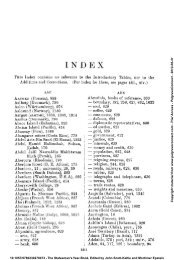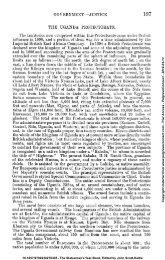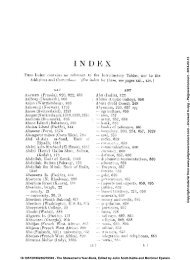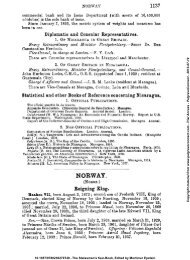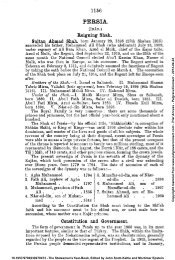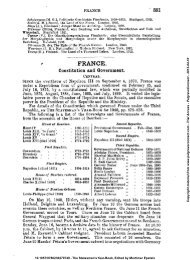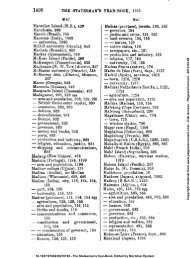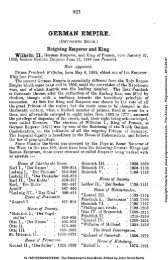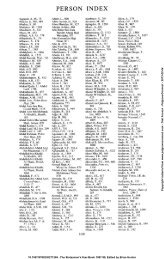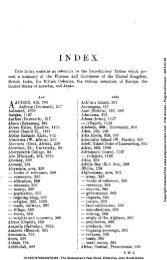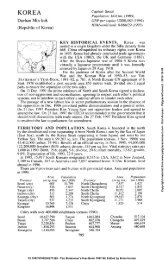Bulgaria - Palgrave Connect
Bulgaria - Palgrave Connect
Bulgaria - Palgrave Connect
Create successful ePaper yourself
Turn your PDF publications into a flip-book with our unique Google optimized e-Paper software.
1104 TURKEY AND TKIHUTAItY STATES :—EGYPT<br />
Extent of holdings.<br />
5 feddans and undci<br />
5-10 feddans .<br />
10-20 ,,<br />
20-30<br />
30-50<br />
Over 50 ,,<br />
Total<br />
Number of<br />
landholders.<br />
. 513,080<br />
75,130<br />
39,620<br />
13,140<br />
8,980<br />
11,430<br />
. 661,380<br />
Totals of<br />
Arena.<br />
Feiiflans.<br />
933,700<br />
552,700<br />
560,300<br />
326,100<br />
347,800<br />
2,000,700<br />
4,721,300<br />
Areas under '<br />
mortgage.<br />
Frikliuis.<br />
21,400<br />
16,000<br />
20,400<br />
19,600<br />
25,900<br />
292,300<br />
395,600<br />
Amount of ;<br />
debt. !<br />
£K.<br />
573,300<br />
392,200<br />
407,700<br />
307,200<br />
409,900<br />
5,233,000<br />
7,323,300<br />
The Egyptian agricultural year includes three seasons or crops. The<br />
leading winter crops, sown in November and harvested in May and June, are<br />
cereal produce of all kinds ; the principal summer crops, sown in March and<br />
harvested in October and November, are cotton, sugar, and rice ; the autumn<br />
crops, sown in July and gathered in September and October, are rice, sorgho<br />
(a sort of maize), and vegetables generally. In Lower Egypt where perennial<br />
irrigation is effected by means of a network of canals tapping the Nile and<br />
traversing the Delta in every direction, the chief crops are cotton, sugar-cane,<br />
rice, Indian corn, wheat, barley, clover, cucumber; in Upper Egypt where<br />
the basin system of irrigation, i.e. submersion at high Nile is generally<br />
adhered to, cereals and vegetables are produced, but in summer cotton and.<br />
sugar-cane are grown in the Fayum and Ibrahimia canal tracts. "Where there<br />
is perennial irrigation two or three crops are secured annually ; lands irrigated<br />
in flood only are under millet, or if low-lying are drained when the flood goes<br />
otf, and then produce the winter crop of wheat, beans, or clover.<br />
Extensive works are in progress at Siut and Assuan for the purpose of<br />
facilitating irrigation.<br />
The production of cotton in 10 years was :—<br />
Year<br />
1890-91<br />
1891-92<br />
1892-93<br />
1893-94<br />
1894-95<br />
Kantars<br />
4,072,500<br />
4,072,520<br />
5,118,150<br />
4,933,666<br />
4,615,270<br />
Year<br />
1895-96<br />
1896-97<br />
1897-98<br />
1898-99<br />
1899-00<br />
Kantars<br />
5,275,383<br />
5,879,750<br />
6,543,128<br />
5,588,816<br />
6,510,000<br />
The area under wheat is (in acres) about 1,262,000; maize, 1,592,000 ;<br />
cotton,' 906,000 ; sugar cane, 67,120. In 1899 the sugar crop exported<br />
amounted to 64,390,550 kilogrammes, valued at £E664,427, and the cotton<br />
exported amounted to 6,001,222 cantars (of 50 kilogrammes), and valued at<br />
£E11,598,222.<br />
In the following table the agricultural condition of each of the provinces<br />
in Lower and Upper Egypt is indicated;—<br />
10.1057/9780230270305 - The Statesman's Year-Book, Edited by John Scott-Keltie<br />
Copyright material from www.palgraveconnect.com - Trial Access - <strong>Palgrave</strong><strong>Connect</strong> - 2012-11-24



